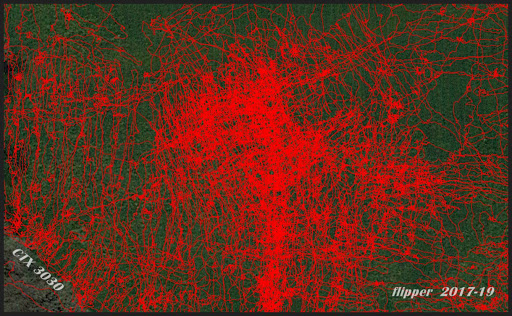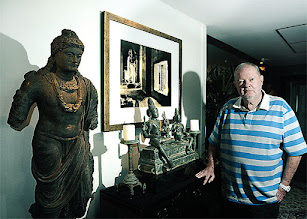When you ask them, British metal detectorists will say to a man, or woman, that they are "not in it for the money", that the hunt for artefacts to add to their collections out of a "passionate interest in history" (that they want to share with everyone) and that the excitement is "going out and never knowing what you will find". That's what they'll tell you and that's what their archaeologist supporters will tell you too (the
Suzies and Bonnies with their fond fantasies about "responsive artefact hunters"). Well, let these academics do some real research, go to the social media of their "partners" and read what they say amongst themselves. I can't think why more archaeologists do not do this, the information is just a mouseclick away (and if you have to find a way round various blocking mechanisms, there might be a reason for their existence, eh?). Anyway, if they did that, they'd find things like this gem from Paul Howard, Let's Go Digging (Admin 11 August 2020):
IMPORTANT NOTICE REGARDING 50/50 Split with our farmers
As you know we recently upped the limit from £500 to £1000 so anything found over £1000 must be 50/50 with our farmers,
As an organiser I know how hard it is to find high value items and hoards and how much time and effort goes into trying to find that something special,
I want all LGD members attending our rallies to be able to keep everything you [sic] find, If your [sic] lucky you ll find Gold milled or Gold Hammered, Roman or nice Saxon coins and rare artefacts, a lot of people don’t have the type of money that they would need to pay the farmers half to be able to keep these type of finds and could end up having to let it go to pay the farmers.
This something I and LGD don’t want to see knowing what it takes and the feeling finding that special find we want you all to be able to keep and feel it’s only fair you should be able too, [sic] As of today 11/08/2020 we have raised the limit to £3000 so anything you find under £3000 is yours without having to split with farmers, We pay our farmers large sums of your money to try and find these items most the time drawing a blank so it’s only right you have a better chance of keeping most items,
So you understand this will take affect [sic] as of today on all NEW farms we book from today, we can’t alter our agreements on farms we already have as contracts are already given, it will state on the events the 50/50 limit for that event so your [sic] all fully aware. We will supply our farmers with signed contracts that say this which LGD will have a sighned [sic] farners [sic] copy, If a find is classed as treasure and kept buy [sic] the BM they automatically split and pay the farmers and finders but if our farmers stick to the agreement we make with them they should only keep half of anything over £3000 so if it’s under and they get paid they should pay the finder the money they received. Not sure how that will work with a farmer who breaks the agreement but it will be made clear to them the situation if this happens and we will only take farms that agree to it,
We hope this now helps you all to be able to keep most of the finds you find with LGD
Paul and Joanne and Team
Let's just get this straight, "
could end up having to let it go to pay the farmers" means actually compensating the landowner for the
loss of their property. Signing a contract with somebody who owns a farm does not mean that they are "your" farms, and "your" farmers, to treat how you want. You are a guest on their property, a paying one. If you pay for a hotel room, it does not entitle you to take the TV when you leave.
As for "
we pay our farmers large sums of your money to try and find these items", the most up to date information from farmers' forums I can find is
this rather notable thread (if you have time, and the stomach, read it through to the end to see who these metal detectorists are)
Apr 20, 2016 Hi, I'm Chris and with my business partner Paul, I run Lets Go Digging. We are paying farmers a up to a £1000 plus to metal detect on their land for one day [...] [for] 100 detectorists, which requires a minimum of 70 acres.
Then the same claim was made
on a village noticeboard two years later. Perhaps they've put the access fee up now to cover the extended risks and facilities needed during a pandemic, but it seems that accepting the possibility they could lose three thousand quid for a cash payment of just 1000 seems a pretty poor deal to me. Farmers are asked to simply accept that an unknown number of artefact hoikers walking off their land taking an unknown number of items worth an unknown quantity of money, though the finders are claiming they are all under 3000 quid's worth. I would love to see how those contracts are worded, and have the PACHI legal team go over them. Why on earth do landowners sign them? I'd also like the public - whose heritage it is - to see the statistics of what is taken under such arrangements (the PAS database does not show many of them). In particular, I'd be interested to know to what degree the ONLY finds that are deemed to be over 3000 quid are Treasure finds that have to be reported anyway. Now the threshold has been raised a third time, from 500 and 1000 to three times as much in order to ascertain that members "have a better chance of keeping most items", how many finds that the finder would previously have been required to share with the landowner are now clandestinely passing into private hands without the landowner being appraised of this? In fact by how much are landowners now out of pocket as a result of this change? The worth of all the objects valued between 501 and 2999 quid, that's how much. Unless they are Treasure.
But then, look at the consequences, Let's say the TVC evaluates a hoard to be worth 10000 quid, and a museum raises that money to buy back everybody's heritage from being sold off elsewhere. Normally the split would be hoiker 5K and landowner 5K but then, per contract (as I understand what is written above), the landowner should only keep half of anything over £3000 so the landowner must give the hoiker more, out of his reward... Say it's a £100,000 reward, split 50-50, so £50,000 each. But then according to the terms of the contract as represented here, the landowner and farmer agreed to split half of the reward over 3K, which is half of 97K, i.e 46.5K. So the the landowner ends up with 46.5K and the Treasure hunter 53.5K.
Reminder, this group has 13,400 followers, probably about half the overall number of detectorists in England and Wales.






































